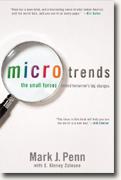Microtrends
Mark Penn and E. Kinney Zalesne
book reviews:
· general fiction
· chick lit/romance
· sci-fi/fantasy
· graphic novels
· nonfiction
· audio books
· author interviews
· children's books @
curledupkids.com
· DVD reviews @
curledupdvd.com
newsletter
win books
buy online
links
home
for authors
& publishers
for reviewers

 |
Microtrends: The Small Forces Behind Tomorrow's Big Changes Mark Penn and E. Kinney Zalesne Twelve Hardcover 448 pages September 2007 |
|
With the current presidential campaign monopolizing every news source and pundits exploring every possible scenario and voter faction, I’d thought analysts had covered every conceivable group and sub-group in America. I picked up Microtrends: The Small Forces Behind Tomorrow's Big Changes
“Many of the biggest movements in America today are small,” says Penn, “[and are] generally hidden from all but the most careful observer.” Drawing inspiration from V.O. Key, Jr., who insisted that “the voters are not fools,” Penn agrees and points out that “it takes intensive, scientific study to find the logical patterns that underlie [their] choices.” But trends move quickly, Penn warns us. Those soccer moms of the ‘90s aren’t the driving force today that they were in 1996 when they helped re-elect Clinton, and smart politicians or marketers will never hang their hopes on an identified group simply because it worked for them in the past. The tricky part, of course, is to determine who the key players are at this moment; to do that, we have to look past our assumptions to spot trends we’ve never conceived of, pay close attention to what people are really doing, then identify the clusters of commonality in that behavior. Is it worth it? Can a handful of oddballs really have an impact on society? Penn believes they can. “…it takes only 1 percent of people making a dedicated choice – contrary to the mainstream’s choice – to create a movement that can change the world (…indeed, it’s the only thing that ever has).” Here Penn gives us over 70 examples of current microtrends, from a broad selection of categories, sharing a bit of gentle speculation about the foundation of these trends. Internet dating, for instance, was once assumed to be an activity peculiar to introverts and the socially inept. Now it’s used by approximately 25 percent of single Americans and many times leads to marriage. Of these ‘Internet Marrieds,’ as Penn calls them, “a remarkable 92 percent say their marriages are happy,” and “…fifty-seven percent think their marriages are stronger because they met online.” Under the topic of Work Life, Penn considers the implications of baby boomers reaching age 65, the traditional age for retirement, but continuing to work for another ten to twenty years. Access to better health care than previous generations enjoyed coupled with our determined grasping for youth and our genuine enthusiasm for our careers has serious implications for employers who must adjust their benefits and draws to keep valuable and experienced older workers happy, as well as for younger workers who will have to wait longer for a chance to move up the seniority ladder. Microtrends Presented in short, snappy segments and infused with Penn’s quirky sense of humor, Microtrends Originally published on Curled Up With A Good Book at www.curledup.com. © Deborah Adams, 2008 |
|
|
|
 Click here to learn more about this month's sponsor! |
|
| fiction · sf/f · comic books · nonfiction · audio newsletter · free book contest · buy books online review index · links · · authors & publishers reviewers |
|
| site by ELBO Computing Resources, Inc. | |
 Well, I suppose we can’t escape politics entirely. Author Mark Penn is, indeed, that Mark Penn. Political pollster, the man who identified ‘soccer moms’ as a critical component of Bill Clinton’s re-election in 1996, and currently chief advisor to Senator Hillary Clinton’s presidential campaign. Thankfully Penn keeps his day job separate from his book, with only a few relevant anecdotes about political matters to demonstrate the power of specific microtrends, which he defines as “small, under-the-radar forces” that have a significant affect on the larger society.
Well, I suppose we can’t escape politics entirely. Author Mark Penn is, indeed, that Mark Penn. Political pollster, the man who identified ‘soccer moms’ as a critical component of Bill Clinton’s re-election in 1996, and currently chief advisor to Senator Hillary Clinton’s presidential campaign. Thankfully Penn keeps his day job separate from his book, with only a few relevant anecdotes about political matters to demonstrate the power of specific microtrends, which he defines as “small, under-the-radar forces” that have a significant affect on the larger society.